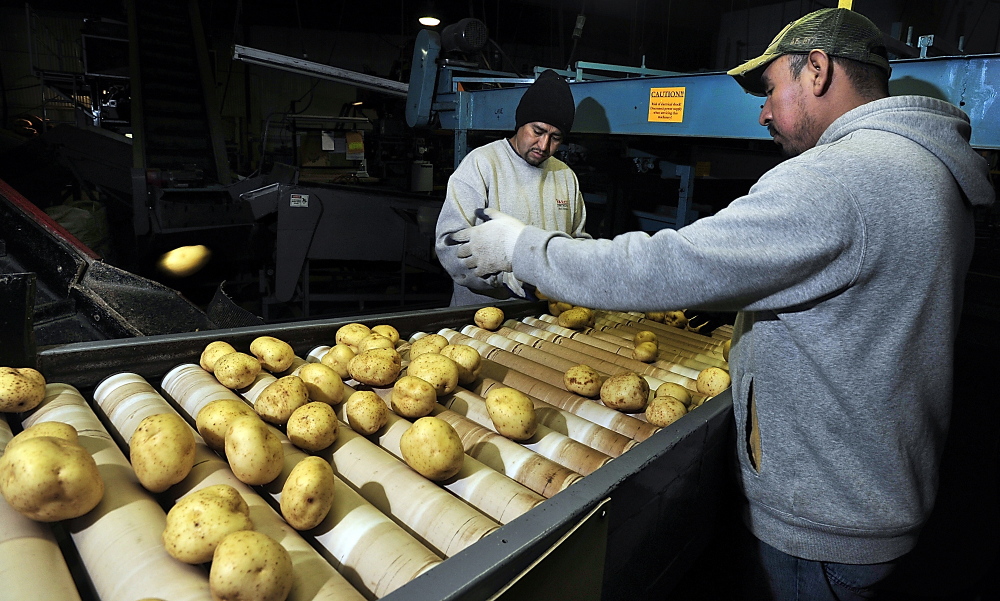The spud’s tarnished image is getting a boost.
Eight years after being banished, the white potato was reinstated to a list of foods approved for a government program serving pregnant women and children.
The Institute of Medicine reversed course on Tuesday and recommended that the white potato – Maine’s largest crop – be eligible for purchase by participants in the U.S. Department of Agriculture’s Special Supplemental Nutrition Program for Women, Infants, and Children.
The WIC program provides grants to states to provide food vouchers to low-income pregnant women, women who have recently given birth, infants and children up to age 5 who are found to be at nutritional risk. The $4.5 billion program served nearly 10 million women and children nationally in 2013. Only a handful of foods meant to boost nutrition are allowed, such as whole grains, low-fat dairy and fruits and vegetables.
Maine Sen. Susan Collins, who is from the Aroostook County city of Caribou in the heart of the state’s potato growing region, has argued for years that the USDA used antiquated rules when it banned white potatoes from the WIC program in 2009, based on a 2006 recommendation from the institute.
“As I have said all along, USDA’s decision ought to be driven by nutritional facts and the latest, accurate food science. In that kind of review, the fresh, white potato wins, hands down,” Collins said in a statement Tuesday.
White potatoes include russet, red, yellow, fingerling, blue and purple potatoes.
“The potato has more potassium than bananas, a food commonly associated with this nutrient, which is important for pregnant women and new mothers,” Collins said. “Potatoes are cholesterol-free, fat-free and sodium-free and can be served in countless healthy ways.”
The Washington, D.C.-based Institute of Medicine, a nonprofit, independent organization that explores health and dietary issues for government agencies, said in its 2006 report that people already ate enough white potatoes. Nutrition advocates supported the recommendation, pointing out that potatoes often are eaten in unhealthy forms, like french fries and potato chips.
The potato industry and lawmakers from potato-growing states, including Maine, last year successfully pushed Congress to bypass the Institute of Medicine’s previous recommendations against the vegetable and include it in WIC as part of a year-end spending bill. The legislation is set to expire this year and Tuesday’s recommendation likely means Congress won’t have to intervene on the issue, according to the Associated Press.
Senator Angus King (I-Maine) also applauded the institute’s recommendation.
“This study further confirms what we have known and consistently advocated for over the years – that fresh, white potatoes are indeed a nutritious and beneficial food that low-income families should have access to through the WIC program,” King said in statement Tuesday. “Decisions about which foods are included in the WIC package should be based solely on science. And the science here is irrefutable.”
Maine ranks sixth nationally in potato production and spuds are the largest agricultural commodity in Maine, according to Don Flannery, executive director of the Maine Potato Board. About 90 percent of the state’s potato crop – 55,000 acres – is grown in Aroostook County.
The Institute of Medicine finding probably won’t boost potato sales, but it will do something much better for Maine’s potato growing industry. It will improve the image of the potato, according to Greg Garrison, a potato farmer in the Aroostook County town of Blaine who runs a 1,500-acre farm with his father.
“It proves the nutritional value of the potato, which we’ve known all along,” Garrison said. “The federal government gave the potato a bad rap, which we never understood.”
The institute’s determination represents a major victory for the potato industry and the consumers who have been unable to purchase white potatoes with a WIC voucher, Flannery said.
“What they did was put a black eye on the potato,” Flannery said. “What this (finding) does is it puts the potato back in a positive light. It’s a real positive thing for the image of the potato.”
Send questions/comments to the editors.



Comments are no longer available on this story